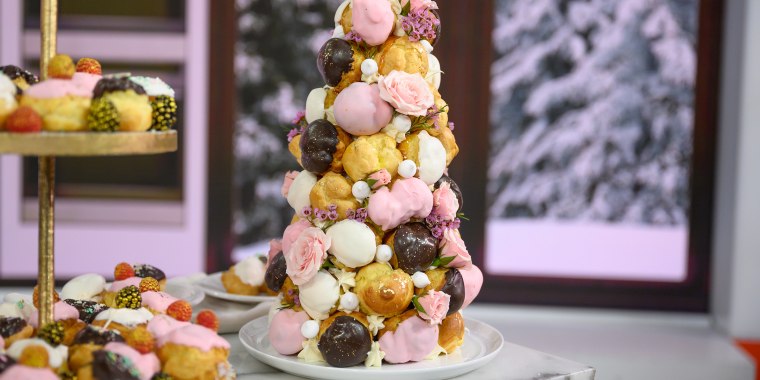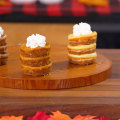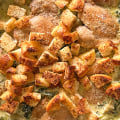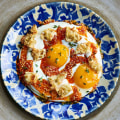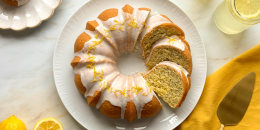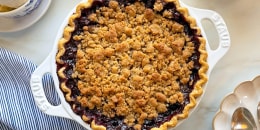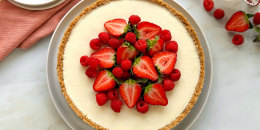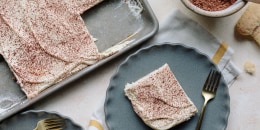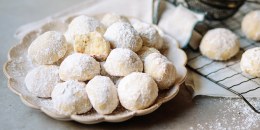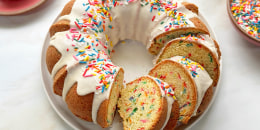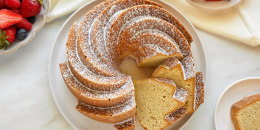Chef notes
Cream puffs are so nostalgic to me and just scream holidays! I love that they're so versatile and poppable. If you want an interactive element to your party, create a cream puff bar! Provide filled cream puffs (or let guests fill their own!), a variety of melted chocolates and topping and let your friends go crazy with their own cream puff creations.
Technique tip: Don't overfill your cream puffs and take care dipping in chocolate so they look neat and professional! Dust berries in food grade shimmer powder for a very high-end touch, or go crazy and use edible gold leaf.
Swap option: Fill with any store-bought custard, pudding or curd. Make a dairy-free filling by substituting cow's milk for any milk alternative.
Ingredients
- 1 cup water
- 1/4 teaspoon kosher salt
- 6 tablespoons unsalted butter
- 2/3 cups minus 1 tablespoon (2¾ ounces) bread flour
- 1/2 cup minus 1 tablespoon (2 ounces) cake flour
- 8 ounces eggs (about 3-4 eggs), room temperature
- 1/4 teaspoon baking soda
- 2 cups whole milk
- 1/2 cup sugar, divided
- Pinch kosher salt
- 6 egg yolks
- 2 tablespoons cornstarch
- 4 tablespoons butter, unsalted, cut into small cubes
- 1 teaspoon pure vanilla extract
- 3/4 cup heavy cream
- 1 cup semi-sweet chocolate
- Raspberries (optional)
- Edible gold dust (optional)
- Powdered sugar, for dusting (optional)
- Sprinkles (optional)
Preparation
For the puffs:
1.Preheat oven to 425°F and line a half sheet pan with a silicone baking mat. (You can use parchment, but silicone is best. If you use parchment here, put a little dough in the corners of the sheet pan before placing the paper, this holds the paper in place.)
2.Bring water, salt and butter to a boil in a saucepan over medium heat. The fat from the butter should be completely distributed throughout the water rather than just floating on top.
3.Sift or whisk the flours together. Remove the saucepan from the heat and add all the flour at once. Vigorously stir the mixture with a wooden spoon or spatula until all the water is absorbed. Make sure to break up any lumps of flour you notice.
4.After the water is absorbed and the mixture is turning into a dough, return to medium heat and cook the dough for 3-6 minutes, moving it around constantly. I like to smear the dough around and shake it in the pan to make sure everything is cooking evenly. You want to cook it until it starts to smell nutty and coats the bottom of the pan in a little fuzz. Once it looks like a big ball of dough that is holding its shape and will hold your spoon upright, pull it from the heat.
5.Add the dough to the bowl of a stand mixer fitted with the paddle attachment.
6.Turn the speed to low-medium speed and mix for 3-5 minutes to cool the dough down. When the dough is cool to the touch, add the eggs one at a time, making sure each egg is incorporated before adding the next. If after you add 3 eggs and the mixture doesn't look glossy and is a little too stiff, add the fourth egg. The amount of eggs can vary and depends on the amount of water that was absorbed and evaporated in the first step of cooking. Then, add the baking soda. The mixture should be pipeable, glossy and should hold a line drawn through it with your finger or spoon.
7.Transfer the dough to a piping bag fitted with a round pastry tip (alternately, you can use spoons or a plastic bag with a snipped corner).
8.Gently pipe out 1½- to 2-inch mounds, leaving an inch in between each. Lightly dampen your fingers and pat down any peaks on top of the dough. (For a crispier crust, lightly dust with powdered sugar before baking.)
9.Bake at 425°F for 10 minutes. Reduce oven temperature to 375°F and bake for an additional 12-15 minutes. Bake a little longer if you piped your puffs on the larger size. You want them to be golden, completely inflated, very light and sound hollow when you tap the bottom.
10.Prick the puffs with a toothpick upon removal from the oven to release steam. Let cool completely.
For the pastry cream:
1.In a medium sauce pot, bring milk, half of the sugar and salt just to a simmer.
2.In a bowl, whisk together the remaining sugar, egg yolks and cornstarch until thick and a pale yellow. Take the simmering milk from the stove and, very carefully and slowly, whisk into the eggs. You should pour in a slow, steady stream while whisking constantly to temper the milk into the eggs and prevent the eggs from cooking from the addition of hot liquid. Once all of the milk is incorporated, return mixture to the stove. Whisk constantly over medium heat until thickened. Pour through a fine mesh strainer to remove any lumps. Mix in the butter and vanilla. Stir until combined. Place a piece of plastic wrap directly on the surface, to prevent a skin from forming and let cool completely. To speed up cooling, pour custard onto a plastic lined sheet tray to expand the surface area. You can also put the bottom of the bowl of custard in a bowl of ice.
3.Once cool, add to piping bag fitted with a star tip and gently fill cream puffs. To make the puffs easier to fill, make a small hole in the bottom with the handle of a clean wooden spoon.
For the topping:
1.Microwave the cream until steaming but take care that it doesn't boil over. Pour over chocolate and let sit for one minute, to melt. Whisk to combine and let cool for a few minutes to slightly thicken.
2.Dip filled cream puffs into chocolate.
3.Decorate with desired additional toppings and serve.
